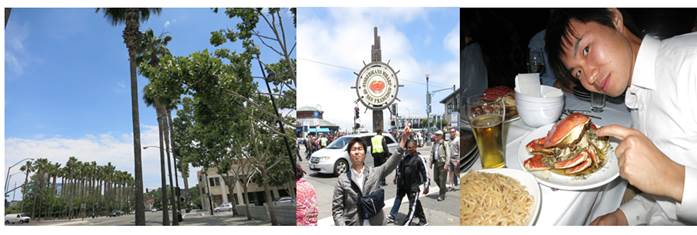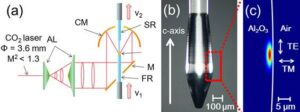CLEO2013 Hiroshi Kudo
Research
CLEO 2013 @ SAN JOSE Conference Participation Report
Hiroshi Kudo, 2nd year Master's student
June 18, 2013
Oral presentations were given at CLEO 2013 in San Jose, California, June 9-15, 2013.
In this report, I would like to report my impressions of the conference as I felt them.

The climate in San Jose is mild, warm and dry throughout the year, and it is very comfortable compared to Japan. Fisherman's Wharf, a tourist attraction in San Francisco near San Jose, was crowded with many tourists, and the Dungeness crab I had at a Vietnamese restaurant called Crustancean nearby was exquisite.

CLEO is one of the largest conferences organized by the Optical Society of America (OSA), and many presentations were made on micro optical resonators, my specialty. Many Chinese and Southeast Asian students participated in the conference. They were attending universities in Canada and the U.S., or collaborating with prominent research institutes to achieve more results. In contrast, there were far fewer Japanese participants, and I wondered if Japanese researchers were doing well.
On the other hand, the short courses are well organized, and I attended the lectures of Silicon Photonics by M. Lipson and Opto-mechanics by Tobias Kipperberg this time. Both lectures lasted for three hours, covering from basics to applications. The lectures were very interesting because the lecturers gave detailed explanations to the students by raising their hands whenever they had any questions. In the oral presentation, the audience showed more interest than in the previous oral presentation at OSA.
Research highlighted]
Optomechanics
There were two Optomechanics sessions, and many reports were presented mainly by Lipson's group. For example, Qm of Si3N4 double disk resonator was analyzed when the mechanical resonance is close to or far from the top and bottom of the structure using the interference of elastic waves (CF1F.6), and deformation of Si and Alumina resonator structure due to temperature (CTu3F.4). The mode analysis for the experimental results of the disk resonator fabricated by SiC (CF2I.4). There was also an interesting presentation in which Qm was analytically raised to 105 units by using two types of Si3N4-based nanobeam structures.
Vahala Group
In the previous CLEO presentation by Vahala's group, FSR, dispersion, and thermal stresses induced by the structure of chemically etched microcavity were discussed in depth (CF2I.1, JTu4A.47). The resonator was fabricated based on the above, and achieved a Q value of 8.75×108 experimentally. A low-loss waveguide called Spiral Wavelength was also presented (JTu4A.50), and the application of these two devices to fiber lasers and Brillouin lasers was reported (JM2N.4, CTh3F.3).
reference data
Nature Photonics, 6, 369-373 (2012).
Applied Physics Letters, 102, 031113 (2013).
Optics Express, 20, 20170-20180 (2012).
Fabrication of microcavities & optofluidics
In this poster session, there were many researches on basic device fabrication (JTu4A.59, JTu4A.87, and JTu4A.49). Basically, none of the experimental results exceeded 104, and analytical results were reported for very low values, such as two or three orders of magnitude. There was also a report on optofluidics by the group of Jelena Vuckovis, which was awarded the Student Prize (CTu3N.6).
Finally, compared to the previous OSA, I felt that my research contents, knowledge, and English language skills have improved, but I could see that they were lacking in front of the world's prominent researchers. At every international conference, I feel a heightened awareness of research, which I cannot feel at domestic conferences. I would like to keep this feeling in my mind in my research.
- Categories
- 国際会議報告



